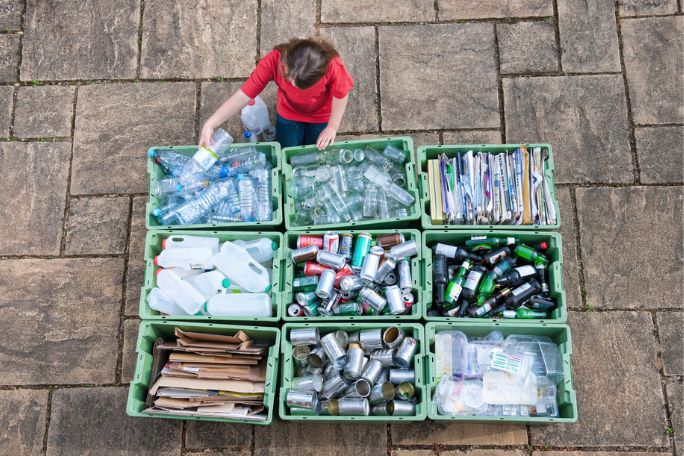Lesson summary
Students explore the properties of different materials and what these materials are used for. They begin by looking at the properties of common classroom objects before thinking about the other places the materials in these objects are used, including in container packaging. They conduct an audit of the classroom bin to identify different materials before thinking about which drink containers are eligible to be recycled with the ACT CDS. Students work collaboratively to communicate messages to an audience about materials, waste and recycling, including the ACT CDS.
Learning intentions:
Students will...
- understand some of the materials that common and uncommon objects are made from
- recognise the different materials found in waste items
- explore strategies for reducing the amount of waste they produce.
Success criteria:
Students can...
- use their senses to explore common objects and to identify the materials these objects are made from
- extend their understanding of these materials to uncommon objects
- participate in a classroom waste audit and help to analyse results
- apply audit results to support and communicate messages around waste and recycling including the ACT Container Deposit Scheme (ACT CDS) to an audience.
Lesson guides and printables
Lesson details
Curriculum Mapping
Australian Curriculum content descriptions:
Foundation Science:
- Objects are made of materials that have observable properties (ACSSU003)
- Pose and respond to questions about familiar objects and events (ACSIS014)
- Participate in guided investigations and make observations using the senses (ACSIS011)
- Engage in discussions about observations and represent ideas (ACSIS233)
- Share observations and ideas (ACSIS012)
Year 1 Science:
- Everyday materials can be physically changed in a variety of ways (ACSSU018)
- Participate in guided investigations to explore and answer questions (ACSIS025)
- Compare observations with those of others (ACSIS213)
- Represent and communicate observations and ideas in a variety of ways (ACSIS029)
Year 2 Science:
- Different materials can be combined for a particular purpose (ACSSU031)
- Participate in guided investigations to explore and answer questions (ACSIS038)
- Compare observations with those of others (ACSIS041)
- Represent and communicate observations and ideas in a variety of ways (ACSIS042)
Syllabus outcomes: STe-9ME, STe-4WS, ST1-12MW, ST1-4WS
General capabilities: Critical and Creative Thinking, Ethical understanding.
Cross-curriculum priority: Sustainability
Relevant parts of Foundation Science achievement standards: Students describe the properties and behaviour of familiar objects. Students share and reflect on observations, and ask and respond to questions about familiar objects and events.
Relevant parts of Year 1 achievement standards: Students describe objects and events that they encounter in their everyday lives, and the effects of interacting with materials and objects. Students respond to questions, make predictions, and participate in guided investigations of everyday phenomena. They follow instructions to record and sort their observations and share them with others.
Relevant parts of Year 2 achievement standards: Students describe changes to objects, materials and living things. They identify that certain materials and resources have different uses and describe examples of where science is used in people’s daily lives. Students pose and respond to questions about their experiences and predict outcomes of investigations. They use informal measurements to make and compare observations. They record and represent observations and communicate ideas in a variety of ways.
This lesson is part of the wider unit of work ACT CDS School Resources
Time required: 60+ mins
Level of teacher scaffolding: High – Young students will need significant support to navigate the ideas of this lesson and to conduct a waste audit of their bin safely
Resources required
- Classroom objects (no special preparation, just what you have around!)
- Contents of a classroom waste bin
- Device capable of presenting a website to the class
- Large sheet of plastic tarp or cardboard
- Student Worksheet – one copy per student
- Waste Safety Code
Skills
This lesson is designed to build students’ competencies in the following skills:
- Creativity
- Adaptability
- Problem solving
- Collaboration
Additional info
The ACT Container Deposit Scheme (ACT CDS) was introduced by the ACT Government in 2018 as a litter reduction initiative. Participants collect and return their eligible drink containers at an ACT CDS return point for a 10 cent refund on each. For further information about the ACT CDS, please visit actcds.com.au
This lesson plan has been developed by Cool Australia, in collaboration with Exchange for Change, the scheme coordinator for the ACT CDS, as part of a suite of curriculum-linked resources for teachers that support schools’ participation in the scheme and enable teachers to discuss the environmental benefits of the scheme as part of their sustainability lessons.


Welcome back!
Don't have an account yet?
Log in with:
By signing up to Cool.org you consent and agree to Cool's privacy policy to
store, manage and process your personal information. To read more, please see
our privacy policy here(Opens in new tab).
Create your free Cool.org account.
Many of our resources are free, with an option to upgrade to Cool+ for premium content.
Already have an account?
Sign up with:
By signing up to Cool.org you consent and agree to Cool's privacy policy to
store, manage and process your personal information. To read more, please see
our privacy policy here(Opens in new tab).